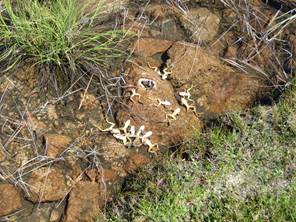|
Amphibian Diseases: Chytrid Fungus
(Chytridiomycosis)
and Ranaviruses |
|
| |
| Causative Agents |
|
Chytrid fungus: |
-
Chytridiomycosis is a skin disease of amphibians that is caused by the
chytridiomycete
fungus, Batrachochytrium
dendrobatidis,
which seems to be specific to amphibians.
-
In general, chytrids are a group of
fungi that are found ubiquitously in soil, water, and
even in the rumen of cattle.
-
It has been documented in various
species of frogs, toads, and salamanders both in captivity and the
wild.
-
Infection can be lethal in some amphibian species, including
boreal toads, but the mode of death is unknown, but it has
been speculated that this
fungus may produce a toxin,
although this idea has not been
confirmed.
|
|
Ranavirus: |
-
Ranavirus is a genus within the
Iridoviridae family of viruses.
|
| Images |
|
Click on
image to
enlarge. |
 |
|
Mountain yellow-legged frogs
killed by chytrid
fungus
(August 2008 -
California, USA). Photo © by Vance Vredenburg |
|
| Distribution |
|
Chytrid fungus |
|
Geographic: |
-
Worldwide.
-
Opportunistic surveys for chytrid
fungus in 2008-2009 indicated that
it is widely distributed in all regions of British Columbia
and in all of the frogs and toads tested.
|
|
Seasonality: |
-
Prevalence of Chytridiomycosis has been reported to be seasonal in
temperate areas, with a higher incidence during cooler
months and a lower incidence during warmer months.
|
|
Ranaviruses |
|
Geographic: |
-
Americas, Asia and
Pacific, Europe.
|
|
Seasonality: |
-
As mortality events due to ranaviruses mostly affect larval amphibians,
die-offs associated with ranaviruses occur in spring and
summer amphibian when larvae are present.
|
|
| Hosts, Transmission and Life
Cycle |
|
Chytrid fungus |
| Hosts: |
|
|
| Transmission
and Life Cycle: |
-
Chytrid
spores are motile (zoospores) but
have limited swimming ability (distances often less than 2
cm) and the
fungus appears to depend on water
flow or host movement for long-distance dispersal.
-
The
fungus grows best between 17 and
25°C and cannot grow at air temperatures higher than 28°C.
|
|
Ranaviruses |
|
Hosts: |
-
The USGS National Wildlife Health Center has isolated
amphibian ranaviruses from 16 species of frogs, one species
of toad and six species of salamanders. Mortality events due
to ranaviruses occur most commonly in larval amphibians such
as mole salamanders (Ambystoma spp.), true frogs (Lithobates
spp. and Rana spp.) and chorus frogs (Pseudacris
spp.).
|
|
Transmission and Life Cycle: |
-
Transmission is via direct contact, ingestion of virus
or infected animals and water exposure.
|
|
| Signs and Symptoms |
|
Chytrid fungus |
-
The waterborne
spores of this
fungus have been found to affect a
variety of tissues, including the skin of post-metamorphic
individuals and the mouthparts of tadpoles.
-
In post-metamorphic
individuals, chytridiomycosis causes a marked thickening of the
skin and excessive
skin sloughing (shedding), which can impair respiration through the
skin and osmoregulation (water balance), resulting in death.
-
Adult amphibians infected with chytrid
fungi also have exhibited
symptoms such as extended back legs, lethargy, and loss of righting
reflex.
-
In larvae, jaw sheaths
and tooth rows of tadpoles lack pigment or appear deformed, which
may impede feeding activity.
-
Overall, it appears
that chytrid infection disrupts the ability of amphibians to
maintain fluid and electrolyte balance, impacting proper muscle and
nerve function.
|
|
Ranaviruses |
-
Field signs of a ranaviral
epizootic
event
include sudden or explosive onset of illness in amphibians in a
wetland, often with hundreds or thousands of sick and dead
amphibians found in a 1 to 5 day period.
-
Overall mortality rates in juvenile frogs and
salamanders in a wetland can exceed 90%.
-
Affected individuals
usually present with subtle to severe hemorrhages in the ventral
(belly) skin, especially at the base of the hind limbs and around
the vent opening.
Hemorrhages
may be present from tip of chin to tip of tail ventrally and may be
pinpoint or irregular patches.
-
Other clinical signs include lethargy, swimming
erratically, weakly, or on their sides, and mild to severe fluid
accumulation under the skin (in lymphatic sacs) of the abdomen and
proximal hind limbs.
-
Internally, there may be fluid accumulation (clear or
red-tinged) in the body cavity (called hydrocoelom), and
hemorrhages
on the surfaces the heart, stomach and liver.
-
Occasionally, white, pinpoint areas of dead tissue are
evident in the liver or spleen.
Ulcers
of the skin and palate tend to be randomly scattered.
|
| Meat Edible? |
-
Meat from amphibians is generally not consumed.
|
| Human Health Concerns and
Risk Reduction |
-
No risk of human
zoonoses has been reported in
relation to infection of amphibians with chytrid
fungus or ranaviruses.
|
| Samples for Diagnosis |
-
Fresh, intact carcasses. Photos of affected animals.
|
| Further Reading |
|
|
|
|
